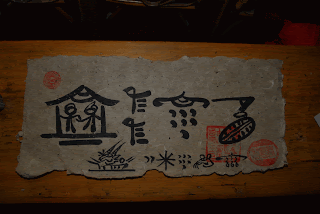
Hannya Masks were used by the traditional Japanese actors of the Noh theatre. These performances with these masks were to show very stylized representations of traditional stories, in
These masks conveyed the identity and mood of the various characters. There were nearly eighty different styled masks in the theatre. Actors took a certain role as a hero, deity, devil, ghost, or legendary animal, depending on the performance. Hannya Masks do not have anything to do with Satan. They are more a concept of a hell in the Japanese Buddhism.
The Hannya Mask is specifically used to represent a vengeful and jealous woman to such a degree of anger that she has turned into a demon, but with human traits left. The most prominent points of these masks are the pointed horns, metal gleaming eyes, strands of hair and a leering mouth split from ear to ear with metal fang-like teeth, combined with expressions of hate.
Masks were made from clay, wood, ivory, dry lacquer, paper, stone, metal, and cloth. The majority of masks are carved from wood and painted. The ivory masks are worth the most value and were made from the tusks of large mammals such as elephants.
Tattooing likes to use these characters in its “flash” by putting good and evil Hannya faces against one another, and tattooed traditionally on the top chest area or as a large back piece. The deeper and more extreme colouring of the face, especially using more reddish colours, indicates the deeper the anger.
Hannya are highly valued and very rare. They should be treasured and passed onto family generations for years to come.
http://www.oldtreasurecove.com/antiqueivoryhannyamasks.php http://www.yoshinoantiques.com/masks.html http://tattoojoy.com/tattoo_articles/the_meaning_of_japanese_tattoos.htm http://library.thinkquest.org/05aug/00717/pages/masks.html











 This tradition, approximately 4000 years old, remains highly regarded over painting and sculpture as through the use of a brush, ink, paper and ink stones are the basic elements and objects used as a means of self expression, communication and cultivation.
This tradition, approximately 4000 years old, remains highly regarded over painting and sculpture as through the use of a brush, ink, paper and ink stones are the basic elements and objects used as a means of self expression, communication and cultivation.




































